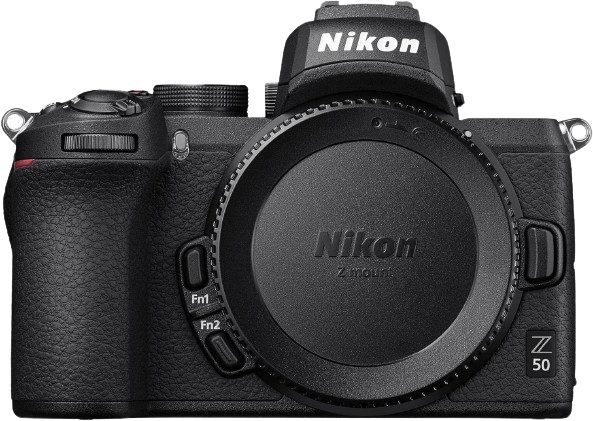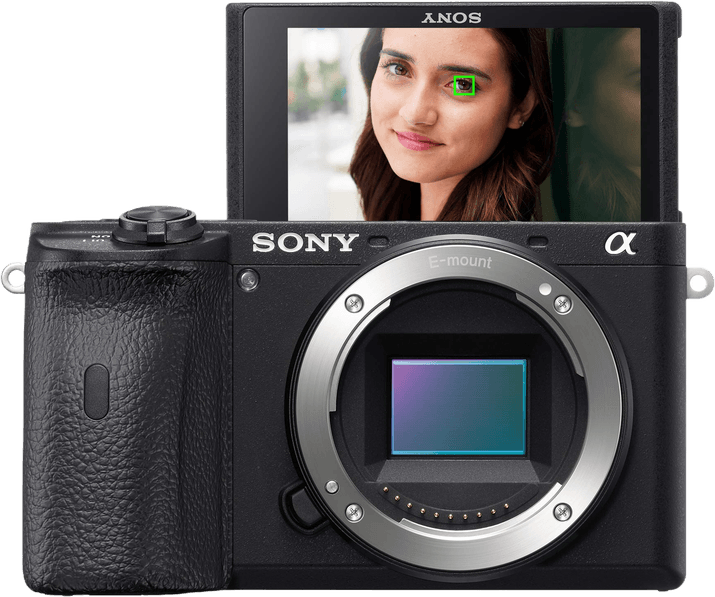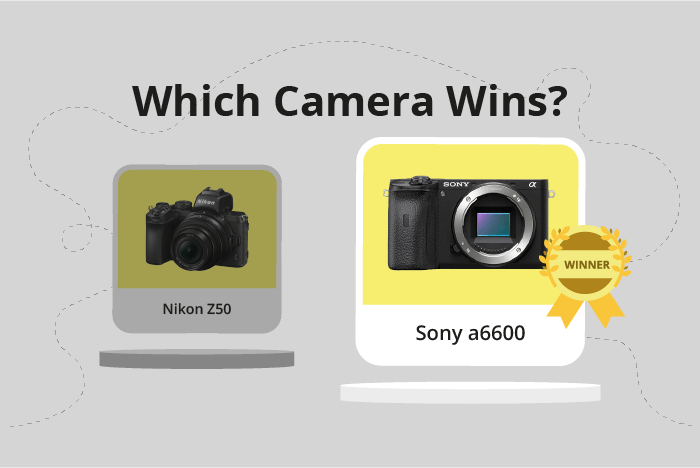Nikon Z50 vs Sony a6600 Comparison
Nikon Z50

Sony a6600

The Sony a6600 edges out the Nikon Z50 with a score of 75/100 compared to 73/100. Both cameras are mirrorless and were released in 2019. They share similar dimensions, with the Nikon Z50 measuring 127 x 94 x 60mm and weighing 450g, while the Sony a6600 is slightly smaller and heavier at 120 x 67 x 69mm and 503g.
The Sony a6600 surpasses the Nikon Z50 with a higher score, indicating better overall performance. However, the Nikon Z50 has an advantage when it comes to price, with a launch price of $859 compared to the Sony a6600’s $1200.
Taking these factors into account, the Sony a6600 may be the better choice for those seeking top performance, while the Nikon Z50 is a more budget-friendly option without sacrificing too much in quality.
Nikon Z50 vs Sony a6600 Overview and Optics
The Sony a6600 outperforms the Nikon Z50 in optics with a score of 76/100 compared to the Nikon’s 72/100. Both cameras share some common specifications, such as an 11 FPS shooting speed, a CMOS sensor, an APS-C sensor size, and a similar lens mount system – Nikon Z for the Z50 and Sony E for the a6600.
The Sony a6600 excels in several aspects. It has a higher megapixel count at 24.2 compared to the Nikon Z50’s 21, allowing for more detailed images. Additionally, the a6600 features image stabilization, which the Z50 lacks. This feature helps to reduce the effects of camera shake, resulting in sharper images, especially in low light conditions or when using slower shutter speeds.
On the other hand, the Nikon Z50 has a higher DXOMARK sensor score of 97, compared to the Sony a6600’s 82. This indicates that the Z50’s sensor performs better in terms of color depth, dynamic range, and low light performance. However, this advantage is not enough to make up for the other areas in which the Sony a6600 outshines the Z50.
Taking all the specifications into account, the Sony a6600 emerges as the superior camera in terms of optics. Its higher megapixel count and image stabilization feature make it a more versatile and reliable choice for photographers looking for excellent image quality. Although the Nikon Z50 has a higher DXOMARK sensor score, it falls short in other critical aspects, making the Sony a6600 the better option overall.
Nikon Z50 vs Sony a6600 Video Performance
The Nikon Z50 and Sony a6600 both earn a video score of 91/100, indicating a tie in their video capabilities. These cameras share several common specifications, such as a maximum video resolution of 4K and dimensions of 3840 x 2160. Additionally, both cameras have built-in time-lapse functionality.
The Nikon Z50 surpasses the Sony a6600 in terms of maximum video frame rate, offering 120fps compared to the a6600’s 100fps. This higher frame rate allows the Z50 to capture smoother slow-motion footage, providing an advantage for videographers who prioritize this feature.
On the other hand, the Sony a6600 does not offer any specific advantages over the Nikon Z50 in video capabilities. Both cameras perform equally well in key areas, such as resolution and time-lapse functionality.
Considering the shared specifications and the Nikon Z50’s advantage in maximum video frame rate, the Z50 is the better choice for videographers seeking slow-motion capabilities. However, the Sony a6600 remains a strong contender for those who prioritize other aspects of camera performance, as it matches the Z50 in resolution and time-lapse features. Ultimately, the choice between these two cameras will depend on individual preferences and priorities in video performance.
Nikon Z50 vs Sony a6600 Features and Benefits
The Nikon Z50 takes the lead with a feature score of 86/100, while the Sony a6600 follows closely with a score of 81/100. Both cameras possess common features such as touchscreen capabilities, flip screens, WIFI, and Bluetooth connectivity. Neither camera has GPS functionality.
The Nikon Z50 has a larger screen size of 3.2 inches compared to the Sony a6600’s 3-inch screen. Additionally, the Z50 boasts a higher screen resolution of 1,040,000 dots, providing a clearer and more detailed display than the a6600’s 921,600 dots. These advantages make the Nikon Z50 a better choice for users who value screen size and resolution in their camera.
Despite its lower feature score, the Sony a6600 still has some advantages. Its autofocus system is known to be faster and more reliable, making it a strong contender for action and sports photography. Additionally, the a6600 has a longer battery life, allowing users to shoot for extended periods without needing to recharge or replace batteries.
In comparing the features of the Nikon Z50 and Sony a6600, the Z50 stands out for its larger screen size and superior resolution. However, the a6600’s autofocus system and battery life should not be overlooked. Ultimately, photographers should consider their specific needs and preferences when choosing between these two cameras.
Nikon Z50 vs Sony a6600 Storage and Battery
The Sony a6600 outperforms the Nikon Z50 in storage and battery with a score of 48/100, compared to the Z50’s 35/100. Both cameras have one memory card slot and support USB charging. They also accept SD, SDHC, and SDXC memory cards. However, the a6600 is more versatile, as it is compatible with Memory Stick Pro Duo cards as well.
The Sony a6600’s battery life is significantly longer, offering 810 shots per charge, compared to the Nikon Z50’s 320 shots. This difference makes the a6600 more suitable for extended shooting sessions without needing to change batteries frequently. The a6600 uses the NP-FZ100 battery, while the Z50 uses the EN-EL25 battery.
Although the Nikon Z50 has a lower score in storage and battery, it still provides decent battery life and storage options for casual photographers. However, the Sony a6600 is the clear winner in this category, making it the better choice for photographers who prioritize longer battery life and storage versatility.
Alternatives to the Nikon Z50 and Sony a6600
Are you still undecided about which camera is right for you? Have a look at these popular comparisons that feature the Nikon Z50 or the Sony a6600:

